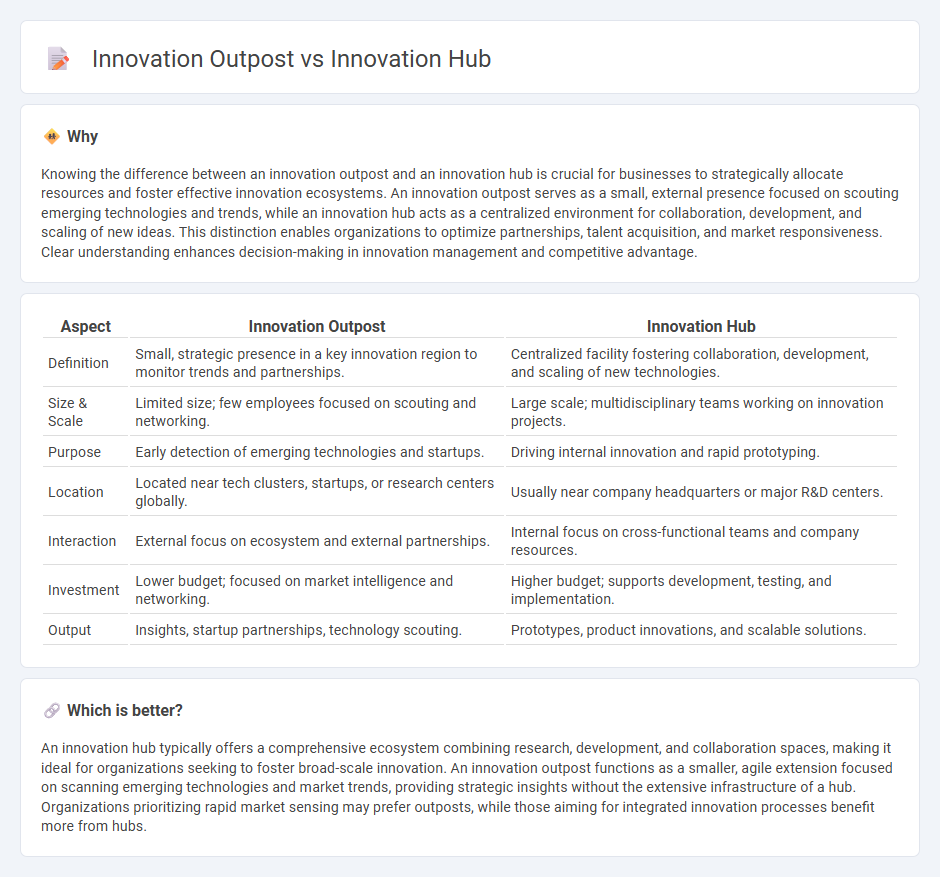
Innovation outposts serve as strategic satellite offices positioned to monitor emerging technologies and startup ecosystems in key locations worldwide, enabling companies to stay ahead in competitive markets. Innovation hubs, meanwhile, act as centralized innovation centers that foster internal collaboration and accelerate idea development within an organization. Discover how choosing between an innovation outpost and an innovation hub can shape your company's innovation strategy.
Why it is important
Knowing the difference between an innovation outpost and an innovation hub is crucial for businesses to strategically allocate resources and foster effective innovation ecosystems. An innovation outpost serves as a small, external presence focused on scouting emerging technologies and trends, while an innovation hub acts as a centralized environment for collaboration, development, and scaling of new ideas. This distinction enables organizations to optimize partnerships, talent acquisition, and market responsiveness. Clear understanding enhances decision-making in innovation management and competitive advantage.
Comparison Table
| Aspect | Innovation Outpost | Innovation Hub |
|---|---|---|
| Definition | Small, strategic presence in a key innovation region to monitor trends and partnerships. | Centralized facility fostering collaboration, development, and scaling of new technologies. |
| Size & Scale | Limited size; few employees focused on scouting and networking. | Large scale; multidisciplinary teams working on innovation projects. |
| Purpose | Early detection of emerging technologies and startups. | Driving internal innovation and rapid prototyping. |
| Location | Located near tech clusters, startups, or research centers globally. | Usually near company headquarters or major R&D centers. |
| Interaction | External focus on ecosystem and external partnerships. | Internal focus on cross-functional teams and company resources. |
| Investment | Lower budget; focused on market intelligence and networking. | Higher budget; supports development, testing, and implementation. |
| Output | Insights, startup partnerships, technology scouting. | Prototypes, product innovations, and scalable solutions. |
Which is better?
An innovation hub typically offers a comprehensive ecosystem combining research, development, and collaboration spaces, making it ideal for organizations seeking to foster broad-scale innovation. An innovation outpost functions as a smaller, agile extension focused on scanning emerging technologies and market trends, providing strategic insights without the extensive infrastructure of a hub. Organizations prioritizing rapid market sensing may prefer outposts, while those aiming for integrated innovation processes benefit more from hubs.
Connection
Innovation outposts and innovation hubs are interconnected by serving as strategic nodes within a company's innovation ecosystem, where outposts scout emerging technologies and trends in external environments, while hubs consolidate insights and accelerate internal development. The outposts enable early detection of disruptive innovations, providing valuable data that hubs leverage to drive experimentation and implement scalable solutions. This complementary relationship enhances organizational agility, fosters continuous learning, and accelerates time-to-market for innovative products and services.
Key Terms
Centralized Collaboration
An innovation hub centralizes resources, talent, and technologies to foster collaborative problem-solving and rapid prototyping within a unified location. Innovation outposts operate as satellite units, focusing on scouting emerging trends and external partnerships while feeding insights back to the main organization. Explore how centralized collaboration in innovation hubs accelerates breakthroughs compared to decentralized outposts.
Decentralized Exploration
Decentralized exploration in innovation hub structures promotes a collaborative environment where diverse teams co-create solutions, fostering local insights and rapid iteration cycles. Innovation outposts serve as strategic extensions in key regions, enabling organizations to tap into specialized expertise and emerging technologies while maintaining alignment with central innovation objectives. Discover how these decentralized models drive agility and competitive advantage in today's dynamic markets.
Strategic Alignment
An innovation hub centralizes resources and talent to drive strategic alignment by fostering collaboration and accelerating idea development within a core ecosystem, enhancing organizational coherence and agility. In contrast, an innovation outpost serves as a satellite unit positioned in strategic locations to tap into local ecosystems, trends, and external partnerships, enabling real-time market insights and adaptive innovation aligned with global objectives. Explore how these innovation models influence strategic alignment and organizational growth.
Source and External Links
Innovation Hub: Home Page - The Eric J. Barron Innovation Hub at Penn State is an 85,000-square-foot facility providing coworking, prototyping labs, and startup support to accelerate innovation, technology commercialization, and entrepreneurship.
Regional Technology and Innovation Hubs (Tech Hubs) - A U.S. government program investing $10 billion over five years to develop regions into globally competitive innovation centers, strengthening economic and national security.
WHO Innovation hub - World Health Organization (WHO) - The WHO Innovation Hub promotes health innovations globally by building ecosystems, scaling innovations in digital health, and providing normative guidance to improve health equity and outcomes.
 dowidth.com
dowidth.com